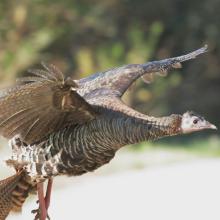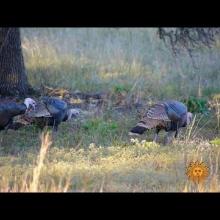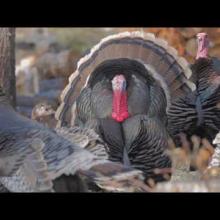

Join BirdNote tomorrow, November 30th!
Illustrator David Sibley and actor H. Jon Benjamin will face off in the bird illustration battle of the century during BirdNote's Year-end Celebration and Auction!
It’s likely that the Mayans of southern Mexico were the first to domesticate turkeys. Early Spanish explorers in the Americas took these domestic birds back with them to Europe, and then early European colonists migrating to America’s Atlantic seaboard brought domestic turkeys back along with them, completing the circle.
BirdNote®
The Wild Turkey - One Well-Traveled Bird
Adapted from a script by Frances Wood and Bob Sundstrom
This is BirdNote.
[Turkeys gobbling]
There’s a rich and interesting history behind America’s favorite holiday bird.
Farmyard turkeys were domesticated from a species called the Wild Turkey, native to the eastern and southwestern states and parts of Mexico.
It’s likely that the Mayans of southern Mexico were the first to domesticate turkeys, maybe 2000 years ago. Early Spanish explorers in the Americas took these domestic birds back with them to Europe, and soon turkeys were gobbling in farm yards over much of the world. [Turkeys gobbling] Early European colonists migrating to America’s Atlantic seaboard actually brought domestic turkeys along with them, completing the circle back to America.
By the early 20th century, Wild Turkey numbers had plummeted across much of the continent, due to overhunting and loss of habitat.
But fortunately, game managers stepped in, re-introducing wild-caught birds to areas where turkeys had disappeared. And — thanks to this hard work — since the 1940s, Wild Turkeys have been prospering. There are now Wild Turkeys running… well… wild in all of the lower 48 states and even Hawaii, far beyond their original range.
[Turkeys gobbling]
For BirdNote, I’m Michael Stein.
And here’s wishing you a Happy Thanksgiving from the entire BirdNote team!
[Turkeys gobbling]
###
Gobble of the domestic turkey provided by Martyn Stewart, Naturesound.org
Producer: John Kessler
Executive Producer: Sallie Bodie
Editor: Ashley Ahearn
Associate Producer: Ellen Blackstone
Assistant Producer: Mark Bramhill
Narrator: Michael Stein
BirdNote’s theme was composed and played by Nancy Rumbel and John Kessler.
© 2019 BirdNote November 2012 / 2019
ID# 112405WITUKPLU WITU-01c
http://www.newenglandhistoricalsociety.com/how-the-wild-turkey-vanished…







